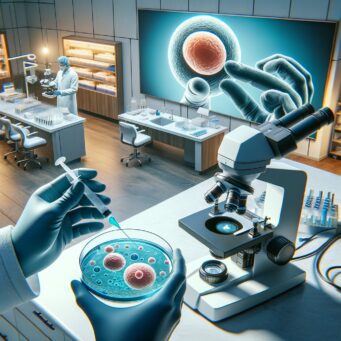
For couples and individuals trying to get pregnant and start a family these days, there’s an almost overwhelming number of possible routes and tests offered—from IVF to donor egg or sperm choices, to pre-pregnancy testing possibilities, and prenatal care and birthing options. Step one for many who don’t conceive naturally with ease, though, often starts with pre-pregnancy genetic testing, to rule out any serious disease which are either incompatible with life, or can lead to serious pregnancy or fetus development complications, such as chromosomal abnormalities or mutations, Huntington’s disease, Tay-Sachs disease, or cystic fibrosis, for example. “The point of any genetic testing is to achieve a healthy child,” explains Jovana Lekovich, M.D., F.A.C.O.G., Medical Director of RMA-NY’s Brooklyn office, in New York City.
Right now, there are essentially two types of pre-pregnancy genetic tests available to help patients achieve a healthy child: carrier screening of the egg and sperm provider, and pre-implantation genetic testing (aka PGT tests), that look at cells from actual fertilized embryos prior to transfer, for anyone taking an IVF route. These tests can work well in tandem for individuals or couples facing pregnancy challenges or concerns. “Carrier screening is also offered right when you go see your OBGYN with a positive pregnancy test, so it is reasonable to do prior to pregnancy and prior to fertility treatment as well, if you plan to do something about it,” explains Julie M.D., F.A.C.O.G., of Pacific NW Fertility and IVF Specialists in Seattle, WA. Lamb adds that there’s a very low chance of an egg and sperm provider both being positive for the same abnormality, “but if that happens, the PGT-M can help avoid a pregnancy leading to a child affected by that specific abnormality.”
Most basically, carrier screening is a simple panel blood test designed to identify genetic carrier diseases. This test can also be used to look into a family history of a serious genetic disorder — such as sickle cell anemia or cystic fibrosis. The expanded carrier screening test also detects genes associated with a wider range of genetic diseases and mutations, to pinpoint whether both sperm and egg providers might be carriers for the same conditions. “Expanded carrier screening is done for both sources of sperm and egg, “ explains Lekovich. The panel tests now look for 503 conditions as of 2020, while before this number was limited to 283 identifiable conditions. “The panels keep growing in scope as we discover new conditions,” says Lekovich, but she’s quick to point out that only 1 to 2% of heterosexual couples will be found to both carry the same conditions which could then result in serious disease for the baby. “In that case, a reproductive specialist will take the route of IVF and create embryos in a lab, and then create a specific probe to check the newly formed embryo for whatever issue has been identified, such as cystic fibrosis,” Lekovich explains. Even in this rare situation, it’s possible that the embryo is unaffected and can lead to a healthy baby.
Expanded carrier screening is done for both sources of sperm and egg,’ “explains Lekovich. The panel tests now look for 503 conditions as of 2020, while before this number was limited to 283 identifiable conditions. “The panels keep growing in scope as we discover new conditions.”
Aside from carrier screenings, there are also three pre-implantation genetic tests, or PGTs, available that doctors can perform on embryos prior to an IVF transfer:
- Preimplantation Genetic Testing for Aneuploidies (PGT-A) is a test that looks for aneuploidies. Embryos with missing the correct amount of genetic material, known as aneuploid embryos, usually fail to implant, which result in a miscarriage, or otherwise develop into a child with a genetic disorder. (Embryos with the correct amount of genetic material are known as euploid embryos, and have a much better chance of resulting in a successful pregnancy.) According to a 2020 study, “modern PGT-A methods can detect mixes of euploid and aneuploid cells with high accuracy, but there is variability between clinics regarding the reported incidence of embryos classified as mosaic with PGT-A at the blastocyst stage. Most recent estimates range between 4%–22%.”
Who is this test recommended for? Patients with genetic disease running in their family, and patients looking to get pregnant after the age of 35, according to Lekovich. “Even if someone does not have a genetic disease, after 35 we recommend PGT-A because age is generally the most common cause of issues with trying to achieve a healthy baby. An error may more likely happen when the fetus is growing from older eggs,” she explains, stating that by 40 years of egg age, 60% of human embryos are going to have some chromosomal abnormality—a number that starts at about 35% at age 35, then goes up about 10 % per year of age thereafter.
Of the three PGT tests currently available, PGT-A is most widely used by far, and would also likely pick up an unknown translocation, notes Lamb. “PGT-A tests for aneuploidy that increases with age, and while the live-birth rate will be the same for patients with and without testing—because if an embryo is going to make a baby, it will do that whether you test it or not— PGT-A helps doctors shorten the time to pregnancy and decrease miscarriages. It also allows doctors to help patients preserve their fertility, by saving normal embryos for future pregnancies,” Lamb explains.
- Preimplantation Genetic Testing for Monogenic/Single-Gene Disorders (PGT-M) is another available pre-pregnancy test that aims to identify specific inherited conditions controlled by one single gene, such as Fragile X syndrome, or sickle-cell disease. For any sperm and egg source, “there is a very low chance of you and your sperm both being positive for the same abnormality, but if that happens, then you can do PGT-M to avoid a child affected by that specific abnormality. But the chance of a patient needing that is very low,” asserts Lamb. “People who chose PGT-M usually come to me with a known mutation or an affected child and want to do IVF just to do that testing,” she adds.
- Preimplantation Genetic Testing for Chromosomal Structural Rearrangements (PGT-SR) is a third option that looks for specific inherited chromosome abnormalities, including reciprocal translocations or inversions. “Patients with a translocation often present with miscarriages, and will come to do IVF, just to be able to do a PGT-SR test on the embryo, to decrease risk of miscarriage, and increase the chance of a live birth,” per Lamb. For those trying to get pregnant with inversions or translocations, this test can save the time and heartbreak of additional miscarriages, and help lead to a healthy baby sooner.
Aside from the carrier screening and PGT genetic tests, Lekovich also notes that if there is a history of prior implantation failure or miscarriages, doctors may check to make sure the endometrial cavity is healthy, via a simple saline ultrasound or hysteroscopy test performed in office. If there’s any need to, a minor ambulatory surgery with local anesthesia allows the doctor to then remove polyps, scar tissue from prior DNC, or fibroids that show up in the uterus, for example, all of which often make proper implantation, even for a healthy embryo, less likely.
For those trying to get pregnant with inversions or translocations, this test can save the time and heartbreak of additional miscarriages and help lead to a healthy baby sooner.
So what does the future of genetic and pre-pregnancy testing look like for hopeful parents? Pretty wild, according to experts in the know, and that’s great news for patients. “Testing is quickly advancing,” says Lamb, “and soon we will have less invasive options. Even a euploid embryo is not 100% successful, so there are things that science doesn’t give us to test for. IVF is emotionally, physically, and financially exhausting, so further testing that can make it more successful, carefully, is welcomed,” she adds.
For those trying to get pregnant with inversions or translocations, this test can save the time and heartbreak of additional miscarriages and help lead to a healthy baby sooner.
As Lekovich sees things, “right now we are swimming in the waters of single-gene disorders like cystic fibrosis and genetic mutations. Where we see the field going, and what is already starting to happen, is testing for poly-genetic problems like diabetes, hypertension, and others that involve multiple genes, because some of these do have a genetic component.” Lekovich emphasizes that this testing is also already highly ethically controversial, however, and not FDA approved yet.
“CRISPR is the other thing that will be huge in the future,” of pre-pregnancy testing, Lekovich adds. For now, embryos are tested, and affected embryos are not used, which is wasteful. “CRISPR will allow an embryo with cystic fibrosis, for example, to be made viable, because it allows us to excise unhealthy genes—cut them out, literally—and replace them with healthy genes,” Lekovich explains. Scientific advances like these are evolving at rapid speed, and within the next couple of decades, experts agree, getting pregnant will likely look very different that it has until now, especially for those who don’t conceive naturally, with ease.
Contributor
Lorraine Allen
Lorraine Allen is a writer, educator and mom to a tween, a toddler, and a hyperactive puppy. Her writing on parenthood and childhood development has appeared in The New York Times, The Wall Street Journal, The Washington Post, and Parents magazine, among other publications. Follow her on Twitter @LorraineAwriter

Listen to stories, share your own, and get feedback from the community.


















